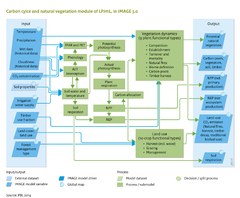Carbon cycle and natural vegetation: Difference between revisions
Jump to navigation
Jump to search
Oostenrijr (talk | contribs) No edit summary |
Oostenrijr (talk | contribs) No edit summary |
||
| Line 2: | Line 2: | ||
|IMAGEComponent=Carbon, vegetation, agriculture and water; Agriculture and land use; Atmospheric composition and climate; Ecosystem services; Land cover and land use; | |IMAGEComponent=Carbon, vegetation, agriculture and water; Agriculture and land use; Atmospheric composition and climate; Ecosystem services; Land cover and land use; | ||
|Model-Database=HYDE database | |Model-Database=HYDE database | ||
|KeyReference=Sitch et al., 2003; Müller et al., in | |KeyReference=Sitch et al., 2003; Müller et al., in revision; | ||
|Reference=Van Minnen et al., 2008; Houghton, 2010; Müller et al., 2007; Ballantyne et al., 2012; Van Minnen et al., 2009; Gerten et al., 2004; Bondeau et al., 2007; Klein Goldewijk et al., 1994; Van Minnen et al., 2000; Van Minnen et al., 2009; | |Reference=Van Minnen et al., 2008; Houghton, 2010; Müller et al., 2007; Ballantyne et al., 2012; Van Minnen et al., 2009; Gerten et al., 2004; Bondeau et al., 2007; Klein Goldewijk et al., 1994; Van Minnen et al., 2000; Van Minnen et al., 2009; | ||
|InputVar=Temperature - grid; Precipitation - grid; Number of wet days - grid; Cloudiness - grid; CO2 concentration; Timber use fraction; Land cover, land use - grid; Irrigation water supply - grid; Forest management type - grid; | |InputVar=Temperature - grid; Precipitation - grid; Number of wet days - grid; Cloudiness - grid; CO2 concentration; Timber use fraction; Land cover, land use - grid; Irrigation water supply - grid; Forest management type - grid; | ||
| Line 15: | Line 15: | ||
Terrestrial carbon cycle and vegetation models contribute to better understanding of the dynamics of the terrestrial biosphere in relation to these underlying processes and to the terrestrial water cycle (see Component [[Water]]) and land use (see Component [[Agriculture and land use]]). | Terrestrial carbon cycle and vegetation models contribute to better understanding of the dynamics of the terrestrial biosphere in relation to these underlying processes and to the terrestrial water cycle (see Component [[Water]]) and land use (see Component [[Agriculture and land use]]). | ||
The IMAGE-2 carbon cycle and biome model ([[Klein Goldewijk et al., 1994]]; [[Van Minnen et al., 2000]]) have been replaced by the Lund-Potsdam-Jena model with Managed Land ([[LPJmL model|LPJmL]]) model ([[Sitch et al., 2003]]; [[Gerten et al., 2004]]; [[Bondeau et al., 2007]]). An overview of the LPJmL model in the IMAGE context with regard to carbon and biome dynamics is presented here; the model and a sensitivity analysis is described in detail by Muller et al. ([[Müller et al., in | The IMAGE-2 carbon cycle and biome model ([[Klein Goldewijk et al., 1994]]; [[Van Minnen et al., 2000]]) have been replaced by the Lund-Potsdam-Jena model with Managed Land ([[LPJmL model|LPJmL]]) model ([[Sitch et al., 2003]]; [[Gerten et al., 2004]]; [[Bondeau et al., 2007]]). An overview of the LPJmL model in the IMAGE context with regard to carbon and biome dynamics is presented here; the model and a sensitivity analysis is described in detail by Muller et al. ([[Müller et al., in revision|in revision]]). | ||
|ComponentCode=NVCC | |ComponentCode=NVCC | ||
|AggregatedComponent=Carbon, vegetation, agriculture and water | |AggregatedComponent=Carbon, vegetation, agriculture and water | ||
Revision as of 09:43, 27 August 2015
Parts of Carbon cycle and natural vegetation
| Component is implemented in: |
|
| Related IMAGE components |
| Models/Databases |
| Key publications |
| References |
Key policy issues
- What is the role of the terrestrial biosphere in the global carbon cycle, how will it change in time as a result of climate and land-use change?
- To what extent can the terrestrial biosphere contribute to reducing the accumulation of CO2 in the atmosphere and what are viable mechanisms?
- What opportunities exist to reduce land-use related carbon emissions (e.g. REDD) and even enhance the carbon uptake through the establishment of new forests.
- What are the contributions of land-use change, climate change and CO2 fertilization on the future carbon cycle and how can these be considered in climate policies?
Introduction
